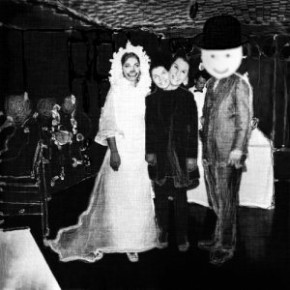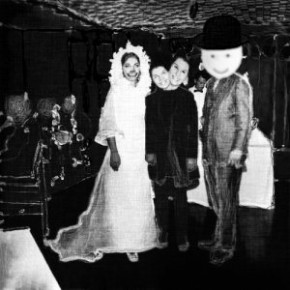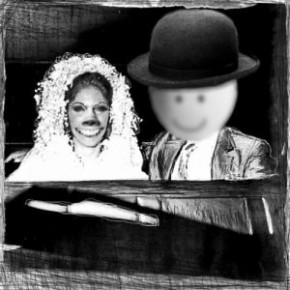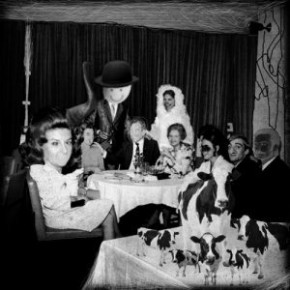Greetings readers, welcome to October 2013’s issue of Synchronized Chaos Magazine. This month’s theme is From The Inside Out, how big themes and larger social ideas play out on an individual level.
This theme can also signify the relationship between structure and function, how the way something is told, created, or done affects its meaning and impact.
Danny Barbare links form and function elegantly through his poetry, with a janitor who views his job as his creative work, figuratively signing his name with his mop. What he does comes from who he is, as he turns something ordinary into something personal and distinctive.
Our regular neuroscience columnist, Leena Prasad, changes things up in this month’s Whose Brain Is It, presenting an entertaining quiz covering the topics of her columns over the past couple years.
Some of her past columns dealt with music and memory, themes Irving Greenfield draws upon in his poetry. Greenfield illustrates how music can affect you, bring about certain memories and sentiments, even for things you don’t think you believe in. Melodies can reach somewhere in the mind deeper than facts or conscious thoughts, and Parisian poet Virginie Colline conveys this power through her evocative, romantic rendition of a moment near the sea. Colline’s words themselves do as much to express this feeling as their meanings, through rhythmical repetition of carefully chosen sounds, in this hybrid of craft and content.
Nigerian political commentator Ayk Adelayok uses similar methods to create a very different musical feeling in his piece, “Nigeria In-Dependence”. He uses punctuation, and short, pointed sentence fragments to call attention to disease, poverty and violence within his home country.
Other authors personalize, or localize, broader concepts. Cultural critic Christopher Bernard reviews Berkeley’s Aurora Theater Company’s production of Amy Herzog’s After the Revolution, where she examines how three generations of a family might be affected by a hypothetical left-wing Western political revolution. Bernard’s review encourages people not to stop working for humane ideals because of the failures in practice of certain governmental systems on both sides of the spectrum.
George Sparling’s new short story, “The Nearness of You” shows an awkward moment between two radically different individuals. The author speculates on the paradox and ideal of tolerating even the intolerant, and the associated dilemmas. Bruce Roberts’ review of Opera San Jose’s production of Falstaff shows people resisting unwanted seduction through cleverness and humor. Some may question whether sexual harassment is a laughing matter, but sometimes making someone’s behavior look ridiculous can serve as a real way to get their attention and disarm them. There is a difference between deriding someone’s behavior by laughing at it, and poking fun at the very idea of the behavior being an issue. And we hope Opera San Jose’s production found an effective way to convey its message.
Several writers use the daily experiences of small groups of characters to touch on deeper issues. Scott Archer Jones creates a memorable bartender whose sense of justice and loyalty transcends the racism of his time, in his short piece “Bear among the Dogs”. Carol Smallwood illustrates the way fiction can both mask real issues and comfort us, sometimes both at the same time, as her narrator struggles through a violent, tumultuous marriage in a town constructed to mimic and honor where Shakespeare created his plays.
John Grey gives a sense of a strong, precise and reserved man from the tightly honed, very concrete description of his son’s thoughts watching him shave, and continues to create these types of characters throughout the rest of his poetry. William Doreski presents prose-style poems showing us mice in his bedroom, his canoeing trips, the outdoors, and a meal where he self-consciously avoids organic produce for fear of losing his manliness. Valentina Cano also creates miniature personal vignettes, poems with bursts of feeling and imagery. She lets us see the river shaped like pus, the grossness of anorexia – and a surprising image of betrayal that does not involve adultery or heartbreak.
The poet who goes by ePLy has included a collection of pieces analyzing our motivations for certain values and behaviors. She questions why we try to manipulate each other to get along, help each other, and live responsibly within nature through fear, guilt and apocalyptic thinking rather than encouraging people to preserve our world out of genuine love and respect. Furthermore, are we good examples ourselves of the behavior we often insist on from others?
Reviewer Kimberly Brown also highlights the value of changing one’s perspective to effect change in one’s own life, as well as the larger world. In Alison Nancye’s Note to Self, one of the books she discusses, she observes how the protagonist learned to stop hating her life and feeling like a victim simply by choosing to identify and work towards her own goals. Brown also provides a unique point of view concerning Katherine ‘Catfish’ Nelson’s novel Have You Seen Me, a coming of age tale dealing with teen runaways, abuse and poverty. Many other reviews focus on the experience of the teens involved, their courage in building new lives, while Brown considers the impact on parents in the small town who would have worried about their own children.
More often than not, different perspectives and ways of viewing situations exist. Our other book reviewer this month, Elizabeth Hughes, looks at titles showcasing methods for and stories of self-improvement and personal resilience in this month’s Book Periscope. She also includes an original poem about her own journey out of homelessness.
I myself was skeptical of the self-help book industry for awhile on behalf of people in situations such as Elizabeth’s. I wondered if authors were simply making money by convincing people dealing with deep personal and societal issues that all could quickly get solved just by following a particular formula, and if it didn’t work, then one must not have done it right. However, Elizabeth had a very empowering experience reading the books, considers them very helpful and feels she learned a lot from them. So I have learned not to so quickly dismiss a genre when it seems to benefit others’ lives, when they perceive the books differently.
Lance Manion’s short story “Risking the Scraped Knee” whimsically looks at how instant fame, even for something quirky, can affect a person’s casual relationships. Italian photographic artist Samy Sfoggia also plays with concepts of memory and importance in her series The happy wedding of Mr. Nobody and Ms. Obvious, ascribing a certain dignity to her fanciful subjects’ ‘wedding’ through making the work resemble treasured heirlooms. She encourages us to consider what we find worthy of remembrance, and why we automatically lend gravity to some people and occasions.
W. Jack Savage illustrates interpersonal violence at large institutions of higher learning in his short piece “The Story of Baggs House”. We see here how some large decisions, which supposedly stem from deep concern for the welfare of the academic fields, or at least the schools, can in fact arise out of jealousy and ego issues among individual people. Yet his piece is not without a redemptive ending, and a note of hope for the human race.
Our dreams, and our music and art, can also reflect our hopes and higher aspirations, coming from our subconscious minds and extending out into the general culture. Fashion columnist Mimi Sylte interviews Lauren Grinnell, founder of Runway to Freedom, a Seattle fashion show benefiting a domestic violence shelter. As in “The Story of Baggs House”, she highlights the possibility of change and transformation for an aggressor, where they can learn healthy ways of relating to people if the process starts early.
Tetman Callis writes about a literal dream in his poetic piece, “After the Dreaming”. Inspired by the native peoples of the American Southwest, the poem suggests a return to a more traditional way of life, described colorfully but without romanticization.
Visual artist Kyle Hemmings also works with dreams, rendering them into colorful abstractions in his set of images. His pieces combine a technical, modern flavor with the energy of the subconscious. Old and classic movies inspire him, and his work thus represents a personal re-imaging of part of our broader cultural heritage.
Richard Hartwell brings us his childhood memories of learning to sail, helping rescue a swimmer, exploring boating technology, and not quite fitting in at the yacht club. These vignettes have a dreamlike quality, as they are vividly imagined, atmospheric, and non-linear, and come across as interesting and nostalgic.
Dave Douglas creates a vision of heaven in his poem “Limitless,” where he looks at flower petals and envisions infinite creativity and hope, symbolically as an ever-growing vine. He describes and idealizes the psychological effects of coming from a place of abundance and gratitude, remembering the goodness and beauty one has and looking forward to the future. For people so often afraid of losing what they have, who tightly grasp onto and fight over resources, this can represent a new way of looking at things. One can also imagine what they would do if nothing got in one’s way, and start working towards that in sustainable ways here.
Thank you very much for taking the time to enjoy this large and complex issue!




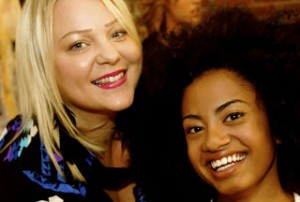
 “If you have nothing and you go to court, and your abuser is right there, sitting there, it would be so much scarier. Like you think, ‘Is he going to be there?’
“If you have nothing and you go to court, and your abuser is right there, sitting there, it would be so much scarier. Like you think, ‘Is he going to be there?’